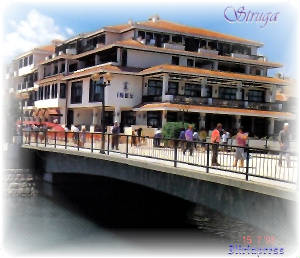|
Struga is the most attractive and a beautiful city located in the north coast of lake Ohri. The city lies
in an altitude of 694m to 700m above the sea level. In Struga live near 20 000 inhabitants, and there are 6000 apartments.
The majority of population of Struga are Albanians and they count to 60% of total population, and the others are Turkish
8%, Slavic 30%, and others 2%. The real figure of the Slavic inhabitants of 30% is 10% Slavic people who live in Struga and
20% of Slavic people who own apartments and houses in Struga, but they live in different cities. The government is counting
the Slavic people two times in order to increase their population. Struga is surrounded with a chain of large villages or
towns. The largest village or town is Veleshta. The main economical muscle of the city of Struga is tourism. The villager’s
main industry is farming and some fisheries. Struga has plenty of hotels, restaurants, small business enterprises that offer
variety of services to the visitors and to residents.The flow of river, Drini i Zi (Black Drin), out of the lake Ohri is a
natural phenomenon which obsesses and ennobles the soul with the best feelings. The river gently flows through the city, on
its way to the Adriatic, makes Struga a significant re creative touristic destination in Balkan Peninsula.

|
| STRUGA |
|
Struga is an old settlement dating from
the Neolithic period. In Antiquity, Struga was located on the road Via Egnatia, the road connecting the Eastern and Western
Roman Empires. The name Struga is an Albanian word “te ruga” meaning on the road. |
|
The old name of Struga was Enhalon, an old
Illyrian expression, and in today Albanian language, “ne valon” which has a meaning of the waving
or flowing. This is not surprising, since the river Drini i Zi flows out from the lake Ohri. The significant si that
the water of the river does not mix with the water of the lake. The river was named based on the road that connected this
southern part of Illyrian with the Adriatic coast or the city of Saragusa. In the ancient time, many people who took
this road, some of them have never come back. Therefore, the lake was named as a Black Drin. In addition,
the name “Drin” means a key to lock or something locked. Based on Roman writings, the area was populated with
Illyrians tribes of Parthynes, Phenestes, and some Enhelians. During the period of 300 - 400, many of those people were
of Jewish religious believes. |
|
In the villages around Struga are churches
build by the Albanians, and taken over from the Slavic populations. Some of those churches are basilicas in the village of
Radolista, village of Oktisi and village of Delogozda, dating from the early-Christian period, 5-6 century. It is clear that
by the time when the Slaves came in this region in the 13-14 century, Struga and its surroundings was a city of
intensive Albanian Christian life development. This can be proved by different subjects dating from this period, and
their excellent treatment. Also, a gorgeous tomb inscription with a pure art design confirms that there were Albanian
people who knew how in the utilitarian to try to find elements of real art. The art works are characterized by the famous
special style from an architectonic viewpoint, especially with rich and valuable carved iconostasis on which a lot of “throne”
and "festive” icons can be found, and the church interior is ornamented with wall fresco-painting. On of the remarkable
work is the icon of St. John which was carved in the walnut piece of lumber dating since a 12-13 century AD. |
|
During the Ottoman Turkey, Struga survived
an Asiatic architectural plans consisting of many Turkish monasteries, baths, masques and other objects. For Example, Asan
Baba in the 18-century AD has built the Muslim monastery called “Halveti Teqe”. The monastery consists five rooms,
that form the letter "T" , and mean the mosque which comprises the minaret and the balcony, caféé-inn, summer inn and
reception room. The cub from the minaret is in octagonal form, which is a symbol of eight heavenly doors, and the crown of
the scheih as well. |
Iliriapress
|
